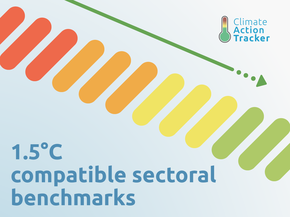Country summary
Overview
China’s emissions in 2023 reached an all-time high due to a rapid rebound in economic activities and fossil fuel consumption after the end of zero-COVID policies. However, thanks to the rapid rollout of renewables and a significant reduction in new coal power projects, the most recent projections suggest that China's emissions will peak before 2025, potentially more than five years ahead of its 2030 target, albeit at a higher level. While there are early signs in 2024 that emissions may be starting to decline from the 2023 peak, it remains uncertain how the rest of the year will unfold.
China has surpassed its NDC target for wind and solar capacity six years ahead of schedule, reaching 1,206 GW in July 2024, with forecasts predicting 1,310 GW by year-end. The country's non-fossil power generation capacity now exceeds that of fossil fuels. However, coal remains China’s primary energy source and the largest emissions source.
Although coal power permits dropped by 83% in the first half of 2024, new coal plant construction remains high due to the surge in approvals of over 100 GW during 2022-2023. Despite this expansion, coal plant utilisation rates are declining, with coal's share of electricity generation falling to 53% in May 2024 from 60% in May 2023, as renewable energy and hydropower recover.
The CAT’s overall rating for China’s policies and targets remains “Highly insufficient”.
We estimate China’s 2023 emissions rose 3% to 14.9 GtCO₂e (excl. LULUCF) compared to 2022, driven by increased coal and oil consumption after the economic rebound from its zero-COVID policy, and further compounded by weak hydropower production due to scarce rainfall.
We expect absolute 2030 emission levels to be up by 0.5-1.6%, compared with our previous assessment, reaching 13.8 to 14.6 GtCO2e (excl. LULUCF). Our conservative scenario expects China’s emissions to peak before 2025, followed by a slight annual decline of 0.5% for the rest of the decade. An optimistic scenario, with accelerated renewable deployment and coal phase-down, suggests CO2 emissions could peak as early as 2023, with a steeper annual decline of 1%, resulting in an additional 5% emission reduction, or 750 MtCO2, by 2030.
In both our optimistic and conservative projections, China’s climate and energy policies are currently not expected to be strong enough to drive down emissions in a substantial manner this decade. For a chance to limit global warming to 1.5 °C, it is critically important for China as the world’s largest emitter to rapidly decarbonise in the short-term by implementing more ambitious decarbonisation policies in its next five-year plan (2026-2030).
As in previous years, our analysis shows emission levels under domestic policies to be lower than China’s energy-related NDC targets. We project China to comfortably overachieve its non-fossil energy share and renewable capacity targets without substantially increasing its mitigation efforts, despite an increased emissions trajectory. China’s wind and solar power capacity has been growing at a record pace, averaging 27% annually over the past five years, surpassing its 1,200 GW target six years ahead of schedule. If China manages to keep up this extraordinary momentum, renewables could meet all its generation capacity demand by 2030, though it would be an enormous challenge.
Given China's continued reliance on fossil fuels, even with an average economic growth of 5% per year in 2024-25, the country may still miss its carbon intensity target—a reduction of 18% by 2025 from 2020 levels—because emissions have not been dropping as expected. This risk is compounded by significant economic losses from extreme weather events exacerbated by climate change, exemplified by the severe flooding in Guangdong, Henan, and Hunan provinces during the summer of 2024.
To strengthen its climate policy and to keep emissions in line with its 2060 carbon neutrality target, China could:
- Control and reduce fossil fuel dependence, as energy consumption is projected to rise almost 9% from now to 2030. While record rates of renewable deployment are on the verge of meeting growing energy demand, this is not yet able to meaningfully cut fossil fuel consumption and bring down emissions in the medium-term. High-level political signals, including President Xi Jinping’s speech at the 20th CPC National Congress and the 2024 Government Work Report from the “Two Sessions” (annual plenary sessions of two of China’s major political bodies), emphasise energy security with coal as a key solution. China reduced coal power permits by 83% year-on-year in the first half of 2024, approving only 9 GW, signalling positive progress. But over the same period, construction began on over 41 GW of coal projects, still representing over 90% of global new coal construction.
- Improve the formulation and coverage of its climate targets by setting an absolute economy-wide peaking target for greenhouse gas emissions as well as specific emission reduction targets for 2035. China’s existing peaking, carbon intensity, and non-fossil energy share targets are relative to economic growth or energy system developments, allowing the country to meet its NDC commitments while increasing emissions levels. The NDC and LTS targets do not directly cover non-CO2 greenhouse gases, which amount to 2.5 GtCO₂e/yr or almost 18% of China’s total emissions, although China has now pledged to include all GHGs in its 2035 NDC.
- Raise the ambition of its energy-related climate (NDC) targets: China reached its 1,200 GW wind and solar capacity target six years ahead of schedule, totalling 1,206 GW by the end of July 2024. China is also on track to meet its 25% non-fossil energy share target by 2030, with our projections suggesting it could surpass 30% in both conservative and optimistic scenarios.
- Accelerate decarbonisation of high-emitting industry sectors by bringing carbon peaking timelines forward, as well as expanding the ETS sector coverage and improving its design. Industry associations and research from public institutions have suggested earlier carbon peaking timelines are feasible for critical sectors such as cement, steel and non-ferrous metals. Production control has been a key solution for China’s industrial emission reduction: after halting new permits for coal-based steel plants in the first half of 2024, the government has now indefinitely suspended all new steel plant permits.
While China’s dependency on fossil fuels and high emission levels looks set to stay for the immediate future, the energy transition continues to build momentum, highlighted by high rates of renewable installations, deepening reforms in the power sector, and mitigation policies in end-use sectors:
- China’s energy transition investments in non-fossil energy, storage, electric vehicles and the circular economy remain a global leader, accounting for 38% of the global total in 2023.
- Renewable energy is rapidly expanding, driven by 14th FYP targets such as generating 3300 TWh of electricity from renewable sources and having renewables make up at least half of incremental power demand growth 2021- 2025. In the first seven months of 2024, China added 160 GW of renewable energy (incl. hydro), which accounted for 87% of new installations. This brought the total renewable capacity to 1,690 GW, making up 54.5% of the country's total power generation capacity. Wind and solar power reached 1,206 GW by the end of July and is forecasted by the China Electricity Council (CEC) to reach 1,310 GW by the end of 2024.
- China is rapidly becoming an electric vehicle (EV) powerhouse, now producing over half of all EVs sold worldwide. Domestically, China's new energy vehicles (mainly EVs) reached a market share of 31.6% in 2023, way ahead of its target of 20% by 2025. It has also released various industry and building sector plans, setting numerous efficiency targets for 2025, some of which rank among the most ambitious globally.
Description of CAT ratings
The CAT rates each country’s targets and policies against (1) its fair share contribution to climate change mitigation considering a range of equity principles including responsibility, capability and equality, and (2) what is technically and economically feasible using modelled domestic pathways which in absence of a better method are based on global least-cost climate change mitigation.
Comparing a country’s fair share ranges and modelled domestic pathways provides insights into which governments should provide climate finance and which should receive it. Developed countries with large responsibility for historical emissions and high per-capita emissions, must not only implement ambitious climate action domestically but must also support climate action in developing countries with lower historical responsibility, capability, and lower per-capita emissions.
The CAT rates China’s climate targets and policies as “Highly insufficient”. The “Highly insufficient” rating indicates that China’s climate policies and commitments are not consistent with the Paris Agreement’s 1.5°C temperature limit and lead to a plateau of high, rather than falling, emissions levels.
China is not meeting its fair share contribution to climate change mitigation. China’s unconditional NDC and policies and action are rated as “Insufficient” compared to its fair share. China’s unconditional NDC is rated as “Highly insufficient” compared with modelled domestic pathways.
To improve its rating, China should set an ambitious and economy-wide absolute emission reduction target and adopt policies to reduce dependence on coal, thereby setting its national emissions on a downward trend.
China's suite of sectoral 14th Five Year Plans set out a range of mitigation measures to prepare the country for a post-coal transition but is unable to counter growing energy demand and reduce dependence on fossil fuels. Under current policies, emissions in 2030 have increased by 0.5-1.6% from the previous assessment, making it more difficult to reach long-term carbon neutrality. The country is expected to well overachieve its energy-related NDC targets, yet it risks failing in meeting its carbon intensity target for the first time. The CAT gives China’s climate policies a rating of “Insufficient”.
This rating is an improvement over the previous assessment of "Highly Insufficient." The change is due to the CAT now rating policies and actions against fair share, rather than the previously used modelled domestic pathway.
The full policies and action analysis can be found here.
Under China’s NDC targets, the country’s emission levels would reach 14.0 GtCO2e/year in 2030. This projection, based on the median value of conservative and optimistic estimates from the two most binding energy-related NDC targets (peaking and carbon intensity targets), represents a 28% increase from 2010 levels.
The country’s existing policies are set to overachieve the NDC targets for the share of non-fossil fuel consumption and the capacity of wind and solar power. This indicates potential for further raising these commitments. However, it is not yet sufficient to ensure that China meets its carbon intensity target.
The CAT keeps its rating of China’s NDC target against modelled domestic pathways in 2030 as “Highly Insufficient”, indicating that its 2030 domestic targets need substantial improvements to be consistent with the 1.5°C temperature limit.
China’s emission levels under its NDC commitments are higher than what would be deemed 1.5°C compatible compared to our “fair share” approach, resulting in our improved rating of the NDC against China’s fair share of “Insufficient”.
This upgrade in rating compared to the previous assessment is due to changes in the underlying data rather than any actual change in the target. This rating takes into account the fact that China has effectively submitted an unconditional NDC target but has not indicated a level of emissions that would be achieved with international support (a conditional NDC target).
China’s President Xi Jinping first announced China’s commitment to reach “carbon neutrality before 2060” in a declaration at the UN General Assembly in September 2020. China has since officially submitted a long-term strategy (LTS) to the UNFCCC in October 2021. As the LTS submission does not meet the majority of our criteria for a best-practice approach in LTS formulation, we keep China’s net-zero target evaluation as “Poor”.
Further analysis
Latest publications
Stay informed
Subscribe to our newsletter





